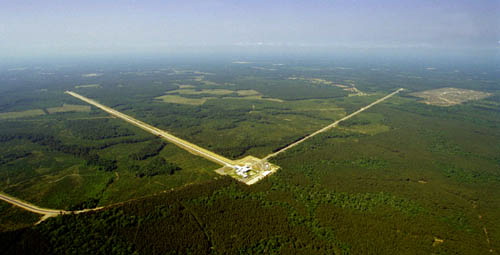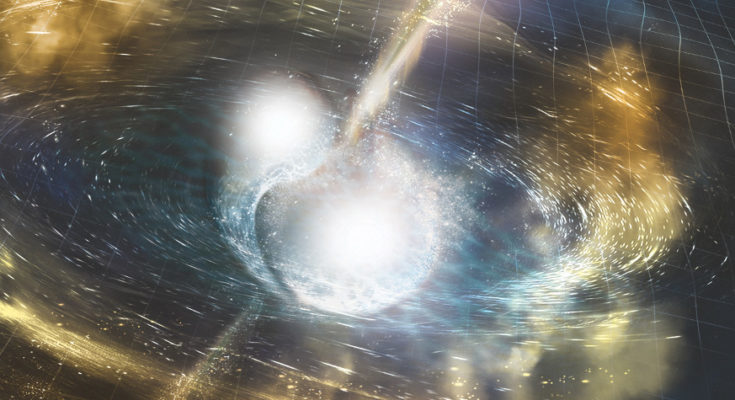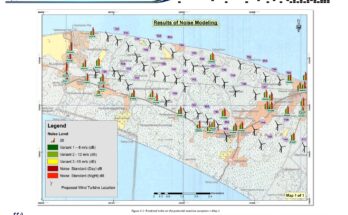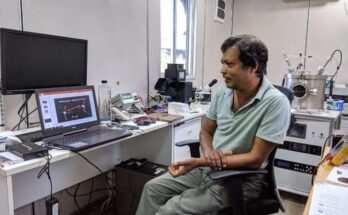Scientists from the Laser Interferometer Gravitational-Wave Observatory (LIGO) project on this Monday 16th October announced the first time ever detection of gravitational waves from a neutron star collision. Apart from the gravitational waves scientists were able to detect light signals too from the same collision.
The discovery was made using the U.S.-based Laser Interferometer Gravitational-Wave Observatory (LIGO); the Europe-based Virgo detector; and some 70 ground- and space-based observatories.
Neutron stars are the smallest, densest stars known to exist and are formed when massive stars explode in supernovas. As these neutron stars spiraled together, they emitted gravitational waves that were detectable for about 100 seconds; when they collided, a flash of light in the form of gamma rays was emitted and seen on Earth about two seconds after the gravitational waves. In the days and weeks following the smashup, other forms of light, or electromagnetic radiation — including X-ray, ultraviolet, optical, infrared, and radio waves — were detected.
“It is tremendously exciting to experience a rare event that transforms our understanding of the workings of the universe,” says France A. Córdova, director of the National Science Foundation (NSF), which funds LIGO. “This discovery realizes a long-standing goal many of us have had, that is, to simultaneously observe rare cosmic events using both traditional as well as gravitational-wave observatories. Only through NSF’s four-decade investment in gravitational-wave observatories, coupled with telescopes that observe from radio to gamma-ray wavelengths, are we able to expand our opportunities to detect new cosmic phenomena and piece together a fresh narrative of the physics of stars in their death throes.”
LIGO detector
LIGO is the world’s largest gravitational wave observatory and a cutting edge physics experiment. Comprised of two enormous laser interferometers located thousands of kilometers apart, LIGO exploits the physical properties of light and of space itself to detect and understand the origins of gravitational waves.
Though it’s called an observatory, LIGO is unlike any other observatory on Earth. Ask someone to draw a picture of an observatory and odds are it will look something like the photo below: a typical telescope dome on a mountain-top. As a gravitational wave observatory, LIGO bears no resemblance to this whatsoever, as the photo of the LIGO Livingston intererometer below clearly illustrates.

Three major facts about LIGO detector
- LIGO is blind. Unlike optical or radio telescopes, LIGO cannot see electromagnetic radiation (e.g., visible light, radio waves, microwaves) nor does it have to because gravitational waves are not part of the electromagnetic spectrum. In fact, electromagnetic radiation from space is so unimportant to LIGO that it is completely isolated and sheltered from the outside world. LIGO cannot (nor does it need to) see anything. Rather, it ‘feels’ for invisible gravitational waves.
- LIGO is the opposite of round. Since LIGO doesn’t need to collect light from stars or other objects in the Universe, it doesn’t need to be dish-shaped like telescope mirrors or radio dishes, which collect and focus electromagnetic radiation to produce images. Rather than having ‘eyes’ typical of astronomical observatories, LIGO really has ears consisting of two straight and level 4 km (2.5 mi.) long steel vacuum tubes, 1.2 m in diameter, arranged in the shape of an “L”, and protected by a 10-foot wide, 12-foot tall concrete enclosure that protects the tubes from the outside world.
- LIGO cannot function alone. While an astronomical observatory can function and collect data just fine on its own (some do not, by choice), gravitational wave observatories like LIGO cannot operate solo. The only way to definitively detect a gravitational wave is by operating in unison with a distant twin so that local vibrations are not mistaken for signals from gravitational waves.
The Detection
On Aug. 17, LIGO’s real-time data analysis software caught a strong signal of gravitational waves from space in one of the two LIGO detectors. At nearly the same time, the Gamma-ray Burst Monitor on NASA’s Fermi space telescope had detected a burst of gamma rays. LIGO-Virgo analysis software put the two signals together and saw it was highly unlikely to be a chance coincidence, and another automated LIGO analysis indicated that there was a coincident gravitational wave signal in the other LIGO detector. Rapid gravitational-wave detection by the LIGO-Virgo team, coupled with Fermi’s gamma-ray detection, enabled the launch of follow-up by telescopes around the world.
The LIGO data indicated that two astrophysical objects located at the relatively close distance of about 130 million light-years from Earth had been spiraling in toward each other. It appeared that the objects were not as massive as binary black holes — objects that LIGO and Virgo have previously detected. Instead, the inspiraling objects were estimated to be in a range from around 1.1 to 1.6 times the mass of the sun, in the mass range of neutron stars. A neutron star is about 20 kilometers, or 12 miles, in diameter and is so dense that a teaspoon of neutron star material has a mass of about a billion tons.
While binary black holes produce “chirps” lasting a fraction of a second in the LIGO detector’s sensitive band, the Aug. 17 chirp lasted approximately 100 seconds and was seen through the entire frequency range of LIGO — about the same range as common musical instruments. Scientists could identify the chirp source as objects that were much less massive than the black holes seen to date.
“It immediately appeared to us the source was likely to be neutron stars, the other coveted source we were hoping to see — and promising the world we would see,” says David Shoemaker, spokesperson for the LIGO Scientific Collaboration and senior research scientist in MIT’s Kavli Institute for Astrophysics and Space Research. “From informing detailed models of the inner workings of neutron stars and the emissions they produce, to more fundamental physics such as general relativity, this event is just so rich. It is a gift that will keep on giving.”
“Our background analysis showed an event of this strength happens less than once in 80,000 years by random coincidence, so we recognized this right away as a very confident detection and a remarkably nearby source,” adds Laura Cadonati, professor of physics at Georgia Tech and deputy spokesperson for the LIGO Scientific Collaboration. “This detection has genuinely opened the doors to a new way of doing astrophysics. I expect it will be remembered as one of the most studied astrophysical events in history.”
Theorists have predicted that when neutron stars collide, they should give off gravitational waves and gamma rays, along with powerful jets that emit light across the electromagnetic spectrum. The gamma-ray burst detected by Fermi, and soon thereafter confirmed by the European Space Agency’s gamma-ray observatory INTEGRAL, is what’s called a short gamma-ray burst; the new observations confirm that at least some short gamma-ray bursts are generated by the merging of neutron stars — something that was only theorized before.
“For decades we’ve suspected short gamma-ray bursts were powered by neutron star mergers,” says Fermi Project Scientist Julie McEnery of NASA’s Goddard Space Flight Center. “Now, with the incredible data from LIGO and Virgo for this event, we have the answer. The gravitational waves tell us that the merging objects had masses consistent with neutron stars, and the flash of gamma rays tells us that the objects are unlikely to be black holes, since a collision of black holes is not expected to give off light.”
But while one mystery appears to be solved, new mysteries have emerged. The observed short gamma-ray burst was one of the closest to Earth seen so far, yet it was surprisingly weak for its distance. Scientists are beginning to propose models for why this might be, McEnery says, adding that new insights are likely to arise for years to come.
What next?
In the weeks and months ahead, telescopes around the world will continue to observe the afterglow of the neutron star merger and gather further evidence about various stages of the merger, its interaction with its surroundings, and the processes that produce the heaviest elements in the universe.
“When we were first planning LIGO back in the late 1980s, we knew that we would ultimately need an international network of gravitational-wave observatories, including Europe, to help localize the gravitational-wave sources so that light-based telescopes can follow up and study the glow of events like this neutron star merger,” says Caltech’s Fred Raab, LIGO associate director for observatory operations. “Today we can say that our gravitational-wave network is working together brilliantly with the light-based observatories to usher in a new era in astronomy, and will improve with the planned addition of observatories in Japan and India.”
RELATED LINKS
Additional resources from the LIGO Scientific Collaboration: http://ligo.org/detections/GW170817.php
Additional Media Assets: http://mediaassets.caltech.edu/nsm
Caltech Story: https://www.caltech.edu/news/caltech-led-teams-strike-cosmic-gold-80074
LIGO Lab Story: https://www.ligo.caltech.edu/news/ligo20171016
Related Papers & Data: https://www.ligo.caltech.edu/page/detection-companion-papers




